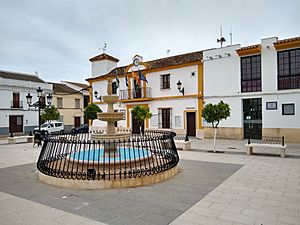Aguadulce, Seville facts for kids
Quick facts for kids
Aguadulce
|
|||
|---|---|---|---|

Plaza Ramón y Cajal
|
|||
|
|||
| Country | Spain | ||
| Autonomous community | Andalusia | ||
| Area | |||
| • Total | 13.69 km2 (5.29 sq mi) | ||
| Elevation | 264 m (866 ft) | ||
| Population
(2018)
|
|||
| • Total | 2,026 | ||
| • Density | 147.99/km2 (383.30/sq mi) | ||
| Time zone | UTC+1 (CET) | ||
| • Summer (DST) | UTC+2 (CEST) | ||
| Website | www.aguadulce.es | ||
Aguadulce is a small town, also known as a municipality, located in the Province of Seville in Spain. In 2018, about 2,026 people lived there. It covers an area of 13.69 square kilometers. Aguadulce is located 264 meters above sea level and is about 99 kilometers away from the city of Seville.
Contents
History of Aguadulce
The region of Andalusia, where Aguadulce is located, has a very long and interesting history. Many different groups of people have lived here over thousands of years. This rich past makes the area very special.
Ancient Settlers
Around 2000 BCE, during the Bronze Age, some of the first people settled near Aguadulce. They lived on top of hills, which was a smart choice. These high spots helped them defend themselves from enemies.
These early settlers were able to make simple objects out of bronze. Some of these ancient tools and items might still be found in the hills today. However, archaeologists would need to dig carefully to find them.
Roman Times
Later, during the time of the powerful Roman Empire, the area where Aguadulce is now was part of a Roman province called Bética. This province was created by the Roman emperor Augustus in 27 BCE. The Romans had a big influence on the culture and way of life in this part of Spain.
A Difficult Time in History
In 1931, a nearby town called Gilena had over four thousand people. Most of them worked in farming. Life was very tough for these workers. They did not earn much money and were often unemployed. Many families in Gilena faced poverty and even hunger.
The Elections of 1931
On April 12, 1931, local elections were held in Spain. This was a big deal because it was the first free election in almost 60 years. In the cities, parties that wanted a republic and left-wing parties won. People in Spain wanted a change in their government to solve their problems.
On April 14, the Second Spanish Republic was announced. Many Spaniards hoped their lives would get better. In rural areas like Gilena, elections were sometimes controlled by powerful local leaders. However, the workers in Gilena were already well-organized.
The General Strike
During the Republic, there were many political parties in Spain. In Gilena, two main groups were active: a left-wing party and a center party. The center party was led by a wealthy landowner. Workers often felt pressured about which party to support.
On October 9, 1931, a group of local officials went to Seville to ask for help from the government. On the same day, socialist workers called for a general strike. They wanted to show how serious they were about their demands. Early in the morning, groups of workers went to the fields to make sure no one was working.
Conflict at the Farmhouse
The most difficult situation happened at a large farm called "Marqués." This farm was very important in the area and was located between Gilena and Aguadulce. Some striking workers tried to convince others to stop working, but arguments broke out.
The striking workers went back to their meeting place to get more help. Meanwhile, people at the Marqués farmhouse called the civil guards from Aguadulce. When about a hundred workers returned, they found civil guards pointing their guns at them. The workers were searched and taken back to Gilena. No firearms were found on them, but they had sticks and stones.
Growing Tension
The civil guard corporal, who did not know Gilena well, led the arrested workers through the town center. This was a mistake. Along the way, more civil guards joined them, making a total of 10. As they entered the village, many people gathered, and the tension grew.
When the arrested workers passed in front of the socialist meeting place, the crowd's shouts became louder. Several workers surrounded the corporal, took his gun, and put it inside their headquarters.
Tragic Outcome
At that moment, when the other civil guards saw their corporal on the ground, they began to shoot. Everyone ran and hid. Many people hid inside the union headquarters. Some even climbed over walls to get to other houses. A few hours later, more civil guards arrived from nearby towns.
Sadly, the corporal and five workers died. Many people were injured, and sixty were arrested. Many others stayed hidden in their homes. Political and military leaders visited the village, and journalists wrote about the events in their newspapers. This was a very sad and difficult day in the history of the area.
Geography of Aguadulce
Aguadulce is a small town located in the central part of Andalusia. It is surrounded by several other towns, including Gilena, Herrera, and Pedrera.
The municipality covers an area of 13.98 square kilometers. To the west, the Río Blanco river separates Aguadulce from the town of Osuna. To the east, Aguadulce shares borders with Gilena and Estepa.
New roads and infrastructure, like the A92 highway, were built for Expo '92. These improvements have helped connect Aguadulce to other parts of Spain.
Aguadulce is about 99 kilometers from Seville, 107 kilometers from Málaga, 122 kilometers from Córdoba, and 143 kilometers from Granada.
See also
 In Spanish: Aguadulce (Sevilla) para niños
In Spanish: Aguadulce (Sevilla) para niños



